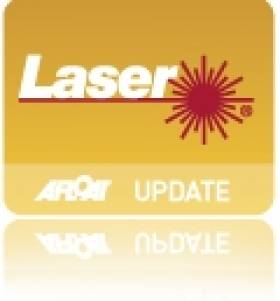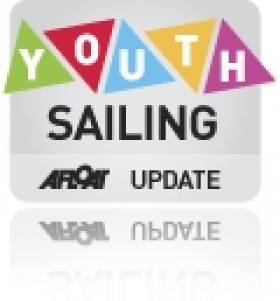Displaying items by tag: Robbie Gilmore
Gilmore Ousts Lynch for Laser Radial Title on Derg
#youthsailing – Robbie Gilmore showed the depth of his talent to win Gold at the Laser Radial Youth National Championships on Lough Derg this afternoon. It was one of five Irish youth sailing titles decided at the inland venue.
Gilmore from Strangford Lough reigned supreme in Tipperary throughout the four day, 11 race regatta to beat last year's champion Finn Lynch in the 44 boat fleet.
Leading from start to finish the Ulster man deservedly won the single-handed title even though with two races to sail today and only five points separating Gilmore and ISAF silver medallist Finn Lynch nerves were running high.
The fleet launched for the 11am start and immediately the two sailors entered in to a duel.
It was overall bronze medallist Fionn Lyden who won the first race but Gilmore came in second followed by Lynch in third which only served to widen the points buffer between them. 12 months of preparation and all that stood in Gilmore's way was one final race. If he could remain close to Lynch on the water he'd win but he did better than that. Robbie Gilmore took the gold medal with style winning the 11th and final race, giving him his fourth bullet of the regatta and a seven point overall lead on Finn Lynch.
And it was another Northern Irish sailor, Sarah Eames from Ballyholme, who took home the gold in the girl's category.
The 420 double-handed class had proved to be highly competitive over the course of the championship. Four teams, two from Dublin and two from Cork, were clear leaders from the outset but which pair would take the overall title was unclear. 11 intense races and plenty of drama only added to the suspense. But ultimately a fourth and a first in today's races secured the win for Robert Dickson and Sean Waddilove from Howth. The pair finished 12 points clear of Peter McCann and Arran Walsh and 13 points ahead of bronze medallists Adam Hyland and Bill Staunton from Dun Laoghaire. First in the girl's category were Cork duo Cliodhna Ni Shuilleabhain and Jill McGinley.
Nicole Hemeryck cemented her success in the Topper class today during two final races. The Dun Laoghaire sailor continued on her streak of posting only top results and never slipping from pole position on the leader board. After eight races, Hemeryck was crowned overall champion with a grand total of 10 points. Both silver and bronze were won by male competitors from Northern Ireland; Liam Glynn with 22 points and Tom Purdon with 28 points.
In the Laser 4.7 class Conor O'Beirne easily maintained his lead by winning both scheduled races. He secured gold with a healthy 12 point lead on Ciaran Finnegan from Waterford. Cliodhna O'Regan began the regatta with a win but couldn't quite manage to repeat the feat. Although she did position herself consistently near the top of the fleet and with a total of 32 points she takes overall bronze and also gold in the girl's category.
There was a dramatic turn of events within the Optimist Championship fleet on their third and final day of racing. Corkonian Emily Whitaker, who had been in first place for the duration, had a tenth in the penultimate race and did not complete her final race. This meant she lost her lead and took home bronze. The overall winner was Tom Higgins from Dublin while Sarah Fogarty, also from Dublin, finished second overall and won gold in the girl's category.
Irish One-Two In Men's Laser Radial At Lake Garda
#Laser - Fionn Lyden and Robbie Gilmore made it a strong one-two finish for Ireland in the men's Laser Radial at the Europa Cup Italy regatta on Lake Garda at the weekend.
September's sailor of the month Lyden is certainly starting the year in impressive style following his runaway victory at the Junior All-Ireland Nationals in his home port of Schull - though Gilmore of Strangford Lough was hot on his heels.
Meanwhile, fourth-placed finisher Finn Lynch of the National Yacht Club - who took the title in 2011 - was just pipped to third position by Poland's Marcin Rudawski.
Further down the field were Royal Cork Yacht Club's Seafra Guilfoyle (8th) and Cian Byrne (18th), and Kinsale Yacht Club's Darragh O'Sullivan (15th) and Ross O'Sullivan (58th).
Elsewhere in the standings at the EurILCA regatta, Howth Yacht Club's Aoife Hopkins finished an impressive sixth in the Laser 4.7 for the women's best result of the four days of sailing at Malcesine.
Hopkins' achievement came with strong showings by Kinsale's Cliodhna O'Regan (14th in the 4.7) and Conor O'Beirne of the Royal St George YC (19th in the men's 4.7).
Also placing in the women's 4.7 were Baltimore's Florence Lyden (33rd) and Royal Cork's Eva Donworth (52nd).
The women's Laser Radial saw placings by Kinsale's Sorcha Ni Shuilleabhain (48th), Ausling Keller of Lough Derg YC (59th) and Chloe Eggers of the Royal St George (85th).
In the men's 4.7, Conor O'Farrell of Carlingford Lough placed 49th while Jack Higgins of the Royal St George was 107th.
In the Standard class, Colin Leonard of Ballyholme Yacht Club finished 37th while Alan Ruigrok of Rush Sailing Club was 48th.
And completing the Irish results in the men's Laser Radial were the Royal Cork's Patrick Crosbie (61st), Dermot Lyden (100th) and Mark Bolger (109th); Kinsale's Dara O'Shea (62nd) and Andrew Levie (126th); Tralee Bay's Tadhg O Loingsigh (75th); Dougie Power of Waterford Harbour Sailing Club (98th); and the Royal St George's Nathaniel Gillet (136th) and Conor Foley (155th).
The complete rankings from the Europa Cup Italy regatta are available HERE.
Royal Cork Yacht Club sailors have lifted two national titles at the 2011 Mitsubishi National Youth Sailing Championships this afternoon in a series cut short today by gale force winds on Dublin Bay. SCROLL DOWN FOR THIS AFTERNOON'S PRIZEGIVING PHOTOS.
Local knowledge offered no advantage as Dun Laoghaire co-hosts the Royal St. George YC, the National Yacht Club and the Royal Irish YC won none of the five national titles inspite of strong turnouts fielded by each of the waterfront clubs.
With winds gusting up to 25-30 knots and easterly winds causing a big swell, sailing for the final day of the ISA Mitsubishi National Championships was cancelled leaving the 300 sailors ashore. However all classes had completed sufficient races to complete the series.
The event was an important test event for Dun Laoghaire organisers of the Youth Worlds which will be held in the same venue from 12 -21 July 2012.
In a show of strength from the regions the three other titles went to other east coast clubs at Howth, Ballyholme and Courtown.
Immediately after the prizegiving, (photos below) Olympic Team Manager James O'Callaghan named the Irish team for the 2011 ISAF Youth World Championships in Croatia in July based on the weekend results. Listen to the podcast with the team manager, talking about the stand out performances of the weekend, the current strength of youth sailing in Ireland and the prospect of a top finish in Croatia.
Royal Cork YC achieved two national titles with Laser 4.7 event favourite Seafra Guilfoyle winning the title having previously dominated the Optimist fleet in previous years.
Brother and sister team Patrick & Chloe Crosbie also from Royal Cork won the 420 National title and Patrick was awarded the Training Grant for the most promising sailor at the event.
This event was the national trials for the Optimist class which was won by Tralee Bay sailor Sophie Browne who will travel to New Zealand in December to compete in the Optimist World Championships.
Irish optimist sailors are performing well internationally at the moment finishing fourth and fifth at the Braassemermeer Easter regatta. Other events during 2011 where there will be Irish representation include the European Championships in Portugal and the National Championships in Germany and the UK.
Top three results below. Click the links for full results class by class.
Laser Radial - full results here
National Champion: Philip Doran (Courtown Sailing Club)
2nd Robbie Gilmore (Strangford Lough YC)
3rd Eoin Keller (Lough Derg YC)
1st Girl Sophie Murphy Quoile Yacht Club
Laser 4.7 - full results here
National Champion: Seafra Guilfoyle (Royal Cork YC)
2nd Darragh O'Sullivan (Kinsale YC)
3rd Finn Lynch (NYC/Blessington SC)
1st Girl: Sian Kneafsey (National YC)
420 - full results here
National Champions: Patrick Crosbie & Chloe Crosbie (Royal Cork YC)
2nd Aodh Kennedy & Daniel Browne (Kinsale YC & Tralee Bay SC)
3rd Emma Geary & Niamh Connolly (Royal Cork YC & Baltimore SC)
Feva - full results here
National Champions: D Johnston & L Flynn Byrne (Howth YC)
2nd C Totterdell & S Craig (National YC/Royal St. George YC)
3rd C Mollard & J Harris (Howth YC)
Topper - full results here
National Champion: T Brow (Ballyholme YC)
2nd Laura Gilmore (Strangford Lough YC)
3rd Andrew Penney (East Antrim BC)
Optimist (Championship fleet)
1st Ben Walsh (Skerries SC)
2nd Ross Quirke (National YC)
3rd Colin O'Sullivan (Malahide YC)
Optimist National Trials
Sophie Browne (Tralee Bay SC) won the trials and took the option of travelling to New Zealand in December 2011 to represent Ireland at the Optimist World Championships.
The following sailors were selected by the trial process to represent Ireland at the European Championship which will be held in Portugal in July 2011: Sean Donnelly, HYC, Peter McCann RCYC, Harry Whitaker RCYC, Eoin Lyden RCYC, Jil McGinley RCYC Cliodhna Ni Shuilleabhain KYC and Megan Parker SSC
The team selected to travel to the German National Championships include Robert Dickson HYC , Daire Cournane KYC, Sean Waddilove Skerries SC, Richard Hogan HYC, Adam Hyland RSGYC, Ronan Cournane KYC, Sean Gambier Ross KYC and Fergus Flood HYC, Aoife Hopkins and Alacoque Daly Tralee Bay SC.
In addition 10 sailors were chosen for the Irish under 12 squad who will compete in the Optimist UK National Championships.
All our youth sailing news aggregated here
Prizegiving photos by Gareth Craig below. For daily on the water action: Day one photos here. Day two photos here. Day three photos here.































































